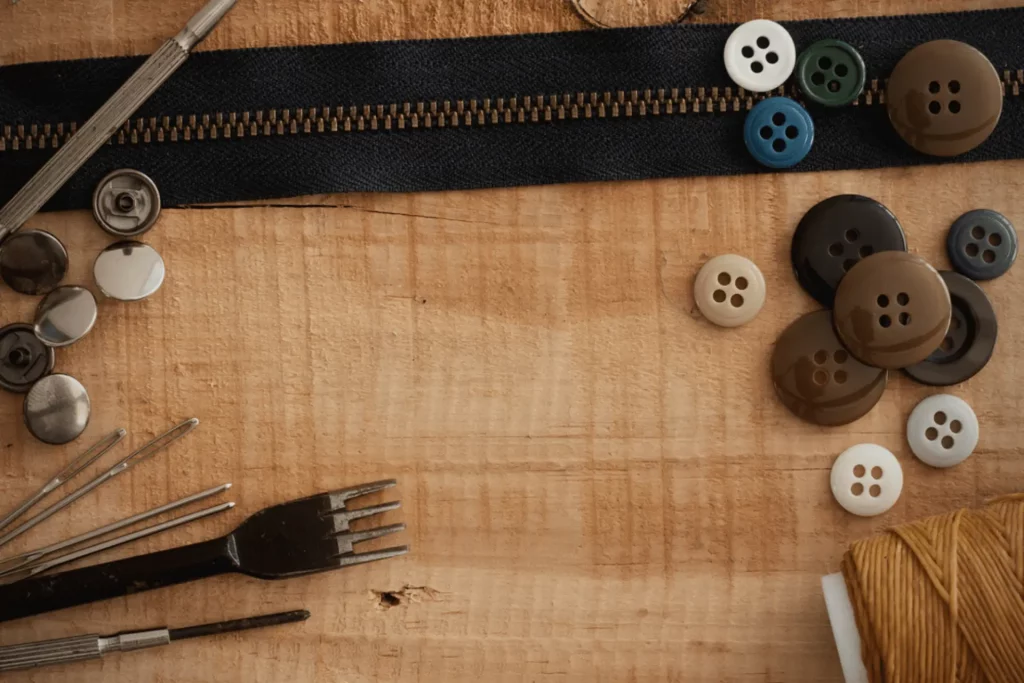If you’ve ever found yourself in a situation where you needed to fix anything made of merino wool, you’re not the only one. Even though this natural fabric is recognised for its strength and durability, even the best-made clothing can eventually become worn out and damaged due to everyday use.
To your relief, there are a few straightforward approaches that you may use to repair some of your favorite woollen goods. Your merino wool will appear as good as new in no time if you only have a little patience and some fundamental sewing equipment.
Table of Contents
How to Repair Merino Wool Garments? Easy Guide!

The following items are required for you to get started:
- A needle and thread
- A fragment of cloth that coordinates (or felt).
- Scissors.
- A piece of sewing equipment (optional).
- Begin by determining the size of the damaged area and cutting a tiny square or rectangle from the fabric that is large enough to cover it. If you are using felt, you must cut out a form that is somewhat bigger than the hole or rip in the fabric.
- After that, you will need to thread your needle and then secure the end of the thread with a knot.
- If the hole in your merino wool is not too large, you should be able to close it by hand stitching it. Put the right side of the cloth facing you and make a couple of tiny stitches through both layers of fabric, beginning from the inside of the garment. When you are completed, make sure to tie a knot in the thread.
- You will need to use a sewing machine to repair any holes or tears that are more significant. To begin, position the piece of fabric so that it covers the damaged area and secure it in place with pins. After that, stitch around the perimeter of the patch, being careful to backstitch at the beginning and the end of each line of stitching.
- Remove any surplus fabric from the surrounding area of the patch, and you are finished!
Following these easy procedures, you won’t have trouble fixing holes or tears in your merino wool clothes. If you take proper care of your clothing, it will continue to serve you well for many years.
How To Fix a Hole in Merino Wool?
It’s possible that when you’re through making repairs, you won’t be pleased with how things turned out, and yes, you’ll likely be able to spot the spot where the hole used to be.
Put another way; your clothing will not always appear as fantastic as it was first purchased. On the other hand, we strongly suggest that you adopt a fresh viewpoint and learn to appreciate the rips and holes in your garments.
These little flaws may serve as a reminder of the day you went outside and got stuck in a bramble bush, but it’s also possible that it was the moment you ran the fastest race of your life or saw the most breathtaking dawn.
You should attempt to darn the hole closed using a needle and thread. This works best for patching up tiny tears or holes. You may also use a patch of similar-coloured fabric that is glued or sewn over the spot if the gap is too large or if the cloth is too fragile.
When dealing with holes of greater size, you may need to recreate the region around the hole. To do this, the damaged cloth must first be removed, and then fresh fabric must be sewed or knit. This approach takes more time but will result in an invisible repair to the naked eye.
The other approach to looking at the holes and tears that have been repaired on your clothing is to consider them a type of tailoring or personalisation that has been done to it. Because of the flaw, the dress stands out from the others and becomes more valuable.
Lastly, another option for getting your clothing repaired is to take them to a professional tailor or shop specialising in tailoring or garment repair. Minor repairs do not often cost much money, and if you are pressed for time or lack the patience to do the repairs yourself, hiring someone to perform them for you can be the best option.
Regardless of your approach, you must ensure that you do not pull or strain the cloth excessively while working on it. This may cause the hole to develop more prominent, making it more difficult for you to patch it. You’ll get your merino wool sweater looking as good as new in no time if you have patience and care for it.
Remove the Buttons and Zips and Replace Them:

Sometimes it is not a hole that must be fixed but something simpler, like a faulty zipper or a missing button. Both are, of course, also capable of being repaired in their own right.
Because replacing a zipper can be a challenging project, you should probably consult an expert or conduct some preliminary study online before attempting to do it yourself.
However, if you get the hang of it, sewing on a button is a simple process that can be finished in about five minutes. Once you have the hang of it, it would be ideal to have the detached button still.
Check whether the item was brought in a little plastic bag attached to the swing tag or if it had an additional button sewn into the label on the inside of the garment.
Suppose you cannot locate the button meant to go with the clothing. In that case, you may either hunt for one that is visually comparable or consider replacing all of the buttons on the garment with new ones so that they all have the same appearance and texture.
What Should You Do to Fix Your Wool Clothing?
As was just discussed, there are many different ways to repair wool clothing, and the one that works best will always rely on what has to be repaired, your current degree of competence, and your preferences. First and foremost, it is better to make repairs sooner rather than later. This is because it is much simpler to patch a small hole than to fix a spot that has gradually gotten larger over time.
What Are the Benefits of Having Your Wool Clothing Repaired?

It could appear the easiest solution when you have a hole in your (wool) clothing to get a new one. To take the time to patch clothing does not appear to be feasible for any of our schedules, given how hectic our lives now are. But before you go ahead and replace it, you should first think about the following facts:
1. Fixing Something Yourself Can Help You Save Money:
The expense of purchasing a brand new article of clothing is far more than the cost of mending the item yourself or even having a specialist perform the work for you. You will save money on each new article of clothing that you do not purchase.
2. Beneficial to the Health of the Environment:
If fewer items of clothing need to be produced, then there will be less of an influence on the environment. As a result, repairing clothing to lengthen its useful life contributes to the conservation of resources and helps to preserve our beautiful world.
3. Acquire and Hone a Fresh Set of Abilities:
It was an ordinary and necessary talent in the past, and our grandparents and maybe even our parents learned how to repair clothing on their own. On the other hand, if you belong to a younger generation, you may have never been instructed on how to patch a hole or sew on a button.
As a result, gaining a new ability that you can use might prove exciting and challenging. Many video lessons on how to mend clothing are available on YouTube and other media platforms. If you want to feel good about yourself, try learning something new; believe us on this one.
4. Activate Your Creative Side More:
When you first start exploring the world of repairing clothes, one of the first things you will realize is that there is more than one way to improve items. You may find yourself coming up with inventive ideas that you had no idea were within you. A joyful mind is also a creative mind.
5. Relieving Stress in One’s Life:
In conclusion, research has shown that working with a needle and thread may truly assist reduce tension and bring about a sense of serenity in the person doing the activity. When we put our whole attention on the activity at hand and get our hands dirty, we can better deal with the pressures and demands of modern life.
We find that being active outdoors is the best way to handle stress, but you could see that doing some stitching from time to time, in addition to other activities, is beneficial to both your body and mind in general.
Frequently Asked Questions:
Is it possible to mend a tear in merino wool?
Hand stitching is usually the most effective method for mending holes or tears in knitted materials, regardless of the type of knitted fabric or how thin the yarn is. The only exception to this rule is tears that occur within or along machine-sewn seams; in these cases, repairing the seam by restitching it with a sewing machine may be the most effective course of action.
What is the best way to repair a little hole in a wool sweater?
You may effectively “weave” in fresh material to patch up that hole in the structure. Find some thread or yarn similar in colour and texture to your work, then thread it through a needle. If you want the cable or cord to be able to be fastened down later when you weave it through your knit, you’ll need to tie a knot in one end beforehand.
Why does merino wool sometimes have holes in it?
The inherent construction of our lovely merino wool clothing makes it vulnerable to damage by moths, namely holes. The caterpillar stage of the clothing moth feeds only on natural fibres, most often wool. If you discover spots in your woolen sweaters or items made of merino wool, this might indicate that you have an infestation of clothes moths.
Bottom Line:
It is time to test your knowledge of merino wool repair now that you are familiar with the process. Have a look at some of the clothes you wear the most often and determine whether or not they may need some care. You must follow a few easy procedures to return their brand-new appearance.

